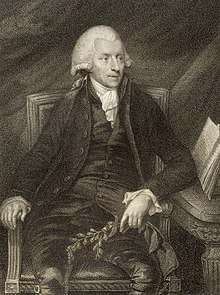Mother Hutton
| Mother Hutton | |
|---|---|
 William Withering and Mother Hutton as imagined by William Meade Prince |
Mother Hutton, also known as Mrs. Hutton, old mother Hutton and "the old woman from Shropshire", was a mythical English character, fabricated in 1928 for marketing purposes by a
The story involved real-life physician
Story

Mother Hutton, also sometimes referred to as 'Mrs. Hutton', 'old mother Hutton' and 'the old woman from Shropshire',
One popular story tells of how Mother Hutton cured the Dean of Brasenose College, Oxford, Dr. Cauley. He came to her with a severe case of dropsy for which she gave her cure.[4] Subsequently, various dates have been given including 1765,[5] 1766[3] and 1776,[4] when she was approached by physician William Withering who sought her recipe and deduced that it was the foxglove that was responsible for the success.[3] His experiments confirmed the hypothesis and he was credited with standardizing the preparations and doses of digitalis.[3]
Later reports

Later sources point to 'Mother Hutton' as being a mythical character,
She was created in 1928 in an illustration by William Meade Prince (1893-1951) as part of an advertising campaign by Parke-Davis (later part of Pfizer) who marketed digitalis preparations.[8] Prince depicted Withering as much older in the painting, as he assumed the discovery happened in 1785.[5]
There is no mention of a Mother Hutton in Withering's works and no mention of him meeting any old woman directly - he is merely asked to comment on a family recipe that was long kept secret by 'An Old woman IN Shropshire'. That is all that Withering says and so all that can ever be known as fact about the old woman. Since 1928, Mother Hutton's status has grown from being an image in an advertising poster to an acclaimed Wise Woman, Herbalist, Pharmacist and Medical Practitioner in Shropshire who was cheated out of her true recognition by Dr. Withering's unscrupulous methods. Withering was in fact informed of the Brasenose College case by one of his medical colleagues (Dr Ash) and the Dean was treated with Digitalis root, not the leaves which Withering recommended. This myth of Mother Hutton has been created by authors not going back to primary sources but instead simply copying and then embellishing the work of others. One book even has Withering chasing round the countryside twice, once seeking a Gypsy woman and then an herbalist, both with secret recipes - simply because the author read two different versions of the story and did not realise they were different versions of the same fake tale.[citation needed]
References
- ^ ISBN 0-19-516127-0.
- ISBN 0-89096-789-X.
- ^ ISBN 0-253-20813-0.
- ^ ISBN 0-912067-03-9.
- ^ PMID 3899150.
- ISBN 9781510712478.
- ISBN 9781788011037
- ^ "The incredible tale of the foxglove, from curing to disease to inspiring Van Gogh's most striking paintings". Country Life. 10 June 2018. Retrieved 24 October 2019.
